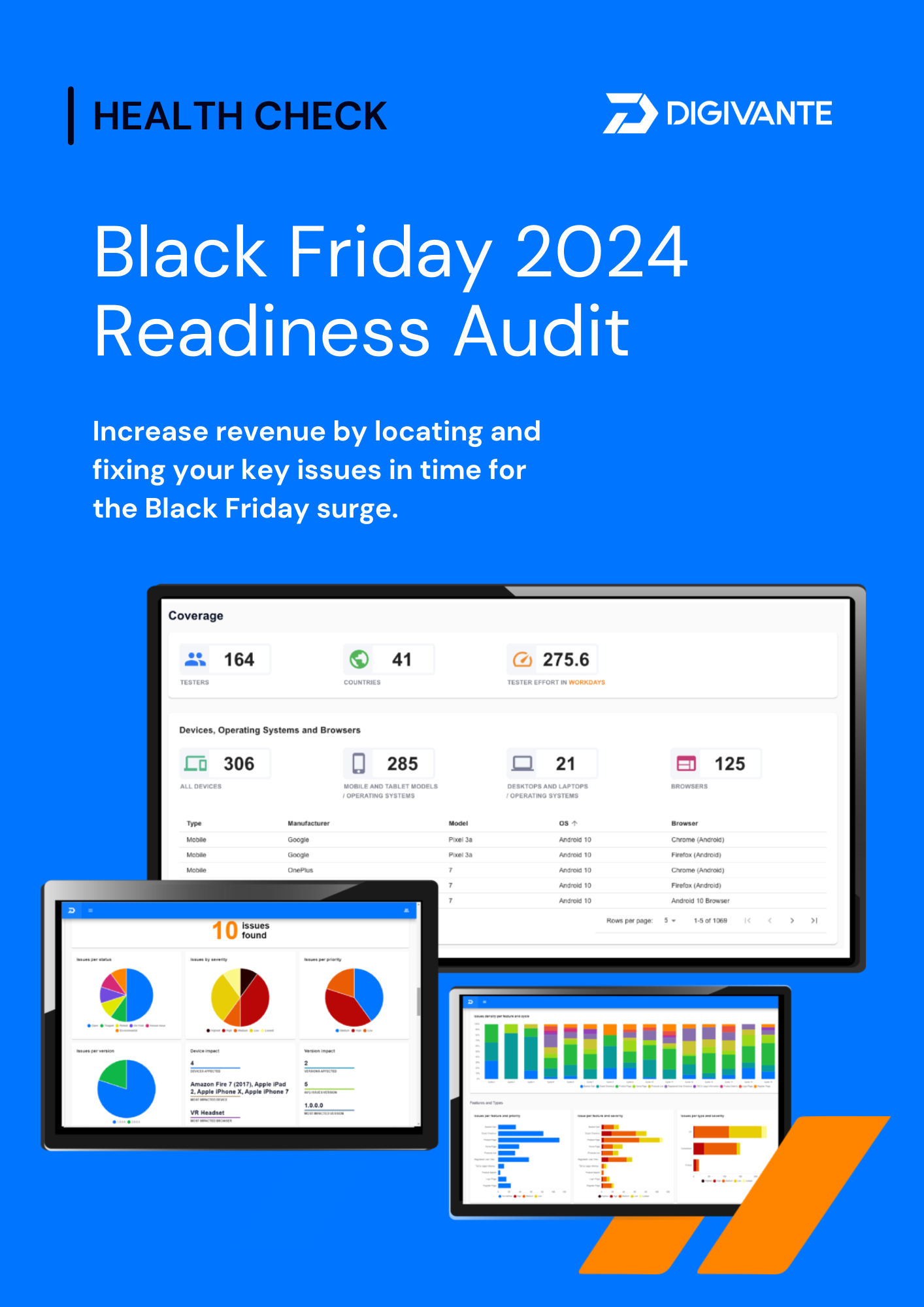Content changes, unforeseen bugs and your conversions
The pressure is on to bundle products, apply discounts, and make quick content changes in the front-end UI to keep up with the demands of this monumental shopping event. However, what often goes unnoticed are the risks lurking beneath the surface—unforeseen bugs that can wreak havoc on your conversions. In this blog, we’ll delve into the challenges ecommerce leaders face in the run-up to Black Friday and how to address them proactively.
The content updates conundrum
When preparing for Black Friday, you’ll likely find yourself making content changes in your website’s front-end user interface. These changes, though seemingly minor, can have a significant impact on your overall user experience and, consequently, your conversions.
CRM (Customer Relationship Management) content management tools are commonplace now. We are told how they are easy to use, and business users are often brought in late to complete content setup without being fully involved in the development of changes within CRMs. Business users are expected to understand the technical aspects of changes. They must carry out the monotonous task of updating products which is at high risk of manual errors.
The assumption game
It’s easy to assume that content changes will seamlessly integrate into your site without causing any issues. After all, you trust your team to make these updates, and they’re experts in their field. However, as experience has shown, this assumption can be a costly mistake.
Real-world examples:
A fashion retailer client we work with launched their Black Friday sale with a large banner at the top of the homepage. This banner included links individual links to Men, Women and Children. The client sees hundreds of thousands of customers visiting their website during sales to grab a bargain therefore any failures during this period have huge financial impact. Within minutes of launch our team of testers found that the link from Men was pointing at Men’s trousers rather than at the full range of clothing.
A global technology company client of ours spent months developing and testing Black Friday offers including free accessories as part of bundles. We assisted with the testing of the setup and configuration which worked as per the business logic and requirements. Business users were expected to complete the configuration in the live environment but unfortunately, they made assumptions on how things worked causing incorrect discounts and product setups.
The blame game
When issues do arise (assuming you get told or know about them), there’s often a blame game between development and content teams. Development claims it’s not their issue because it’s a content change, while content insists it’s a technical problem. This finger-pointing can lead to delays in resolving issues, and during the fast-paced Black Friday rush, that’s a luxury you can’t afford.
The most common conversion blocking issues
Here’s a list of the most common issues that etailers encounter during the Black Friday shopping rush:
Sale products & prices not set up correctly:
One of the most critical aspects of Black Friday preparations is ensuring that sale products and their corresponding prices/ discounts are configured accurately on your website. Common issues in this category include incorrect pricing information, discounts not applied as expected, or sale products not appearing in the designated sale sections. These issues can lead to customer frustration and cart abandonment, as shoppers may expect certain discounts but are met with unexpected prices during checkout.
Mismatch in product prices between PLP/ PDP & basket/ checkout:
Black Friday shoppers often browse through product listings (PLP – Product Listing Page) and product details (PDP – Product Description Page) before adding items to their cart and proceeding to checkout. Any discrepancies between the prices displayed on PLP/PDP and the prices shown during the checkout process can confuse and deter customers. Retailers must ensure that prices remain consistent throughout the customer journey to avoid cart abandonment and potential trust issues.
Inability to complete payments/ issues placing orders:
Perhaps one of the most frustrating experiences for shoppers during Black Friday is encountering difficulties when trying to complete a purchase. Payment processing issues, such as declined transactions or payment gateway errors, can cause customers to abandon their carts. Additionally, technical glitches that prevent customers from placing orders can result in lost sales opportunities. Ensuring a smooth and reliable payment process is paramount during this critical shopping period.
Discrepancies with delivery costs, especially with discounted items in the basket:
Delivery costs can make or break a sale, particularly during Black Friday when customers are actively seeking deals. If delivery costs appear unexpectedly high or if there are discrepancies in delivery fees between what was initially displayed and what customers see in their carts, it can lead to cart abandonment. Retailers should ensure that delivery costs are transparent and clearly communicated, especially when offering discounts on products.
Problems with purchasing a mixed basket:
Many Black Friday shoppers compile a mix of regular-priced and sale items in their shopping carts. Technical issues or pricing discrepancies that arise when customers attempt to purchase a mixed basket can be a significant roadblock. It’s essential to thoroughly test and optimise your website to handle these scenarios seamlessly, ensuring that customers can successfully purchase a combination of discounted and regular-priced products without issues.
Addressing these common issues requires meticulous planning, continuous testing, and proactive monitoring of your ecommerce platform in the lead-up to Black Friday. By addressing these challenges and providing a smooth shopping experience for your customers, you can maximise conversions and make the most of this high-stakes shopping event.
How to avoid these issues this Black Friday
Sale products & prices setup:
Early testing: Start preparing well in advance of Black Friday by testing all sale products and pricing configurations on your website. Ensure that product discounts are correctly applied, and prices are accurate.
Price consistency across pages:
- Real-time synchronisation: Invest in a robust ecommerce platform that ensures real-time synchronisation of product prices across all pages, including PLP, PDP, and the checkout process. This eliminates the risk of price mismatches.
Smooth payment processes:
- Payment testing and load testing: Perform rigorous payment testing on your payment processing systems to ensure they work exactly as they should during Black Friday. Identify and address any bottlenecks or slowdowns with load testing.
- Payment gateway redundancy: Consider using multiple payment gateways to provide customers with alternative payment options in case one experiences issues. This can prevent widespread payment failures.
Transparent delivery costs:
- Clearly display delivery costs: Clearly communicate shipping costs on product pages and in the shopping cart. Ensure that any discounts or free shipping offers are prominently displayed to set customer expectations.
- Dynamic delivery calculators: Implement dynamic delivery calculators that provide real-time delivery cost estimates based on the customer’s location and order details. This minimises surprises during checkout.
Mixed basket purchases:
- Unified pricing rules: Establish unified pricing rules for both regular and sale items to avoid discrepancies when customers purchase a mixed basket.
- Thorough testing: Rigorously test various scenarios, including mixed basket purchases, to ensure that your website’s shopping cart and checkout process can handle them without issues.
Ongoing monitoring:
- 24/7 monitoring: Employ a dedicated team and/or automated monitoring tools to keep a constant watch on your website’s performance and functionality during the Black Friday period.
- Rapid Response: Be prepared to address any issues that arise promptly. Have a clear escalation plan in place to involve the right teams when needed.
By implementing these strategies and conducting thorough testing, you can minimise the risk of common conversion-blocking issues during Black Friday. Proactive planning and monitoring are key to providing a seamless shopping experience for your customers and maximising your conversions during this critical sales event.
The Black Friday Readiness Audit solution
In the midst of these issues and challenges, there’s a lifeline: the Black Friday Readiness Audit. As a crowdtesting provider, we specialise in rapidly identifying issues that might arise from content changes and other aspects of your Black Friday preparations.
Exploratory testing for peace of mind
Digivante offers exploratory testing, which assesses how your website or app behaves up to the point of purchase. This comprehensive testing approach provides you with a prioritised list of conversion blockers, giving you peace of mind that your site is ready for Black Friday.
Unearthing issues
During exploratory testing, Digivante uncovers issues such as form glitches, broken links, sluggish site speed, device-specific bugs, typos, checkout journey hiccups, and malfunctioning payment methods. By addressing these issues before Black Friday, you can safeguard your conversions and customer experience.
Black Friday is a monumental event for ecommerce, and your preparations are crucial to its success. Don’t let content changes and unforeseen bugs jeopardise your conversions. Instead, proactively address these challenges with the help of Digivante’s Black Friday Readiness Audit. By doing so, you’ll ensure that your site is in top shape, ready to handle the Black Friday shopping frenzy and deliver an exceptional user experience.
So, as you gear up for the biggest shopping event of the year, remember that with the right testing and support, you can navigate the Black Friday challenge with confidence. Your conversions and customers will thank you for it.







